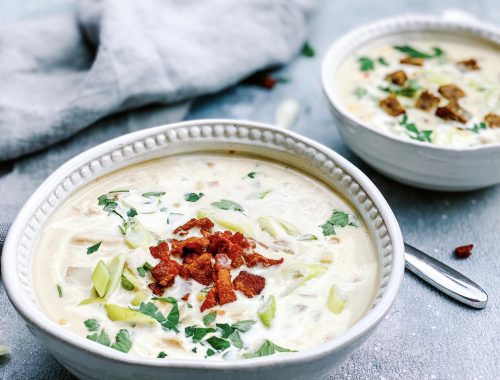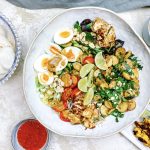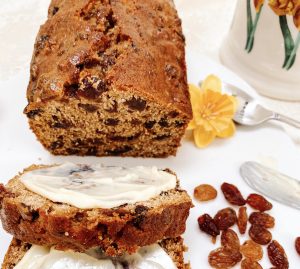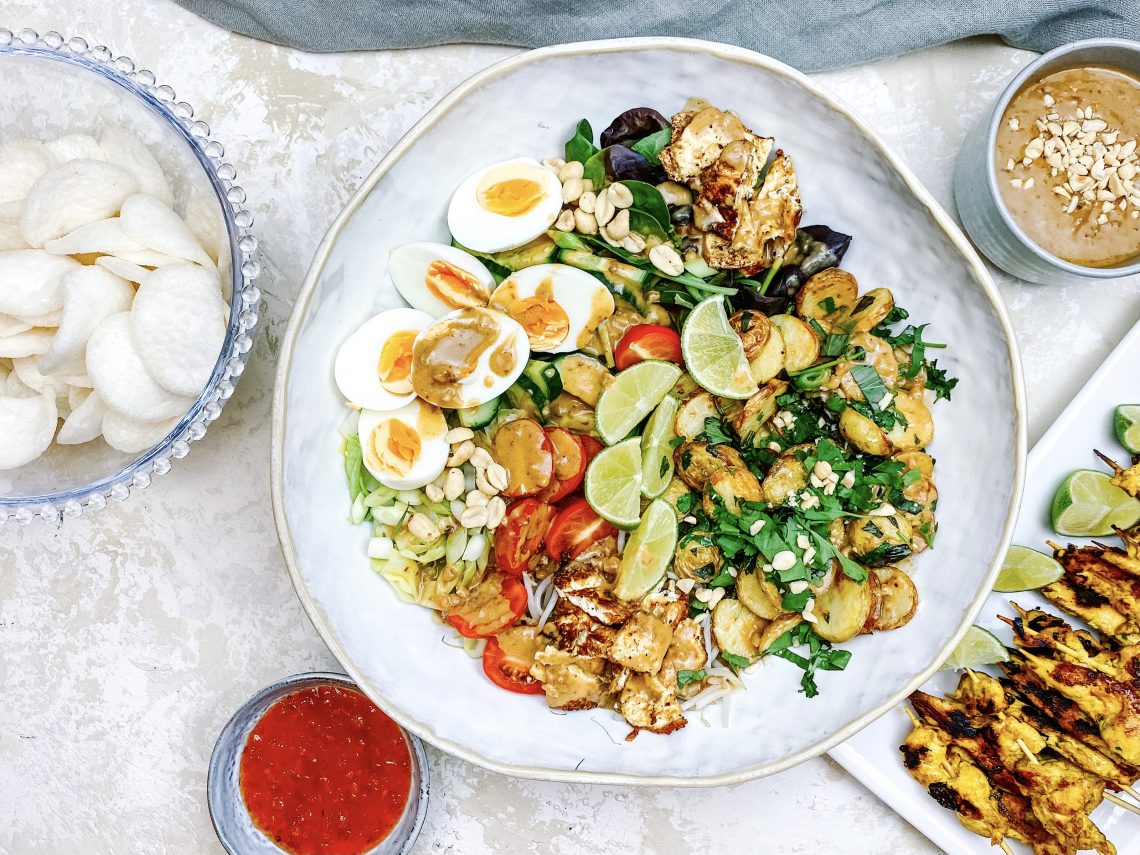
Gado Gado
Gado Gado is an Indonesian salad made using blanched or quickly steamed vegetables, cooked potatoes, hard boiled eggs, some tofu or tempeh, all drizzled with an unctuous and spicy peanut sauce and served with prawn crackers on the side. An incredible blend of flavours and textures and, even better, wonderfully healthy (mostly!).
If you put gado into google translate, it comes up as hodgepodge – which really, is exactly what this is. Like most classic recipes, there are many variations – regional and family – but in essence it is a plate of mixed vegetables, served with vegetarian protein and of course, elevated by the incredible peanut sauce. I vary the vegetables I use but I like to include cooked potatoes, blanched beansprouts and cabbage as well as some raw vegetables and some fresh herbs. I’m not a huge tofu fan, but I do enjoy it crisply fried and I always include hard boiled eggs. (Omit the eggs if you prefer a vegan meal.) Typically the cooked potatoes are boiled or steamed, but, if I have time, I like to par-boil the potatoes and then roast them in the oven for extra flavour and crunch. I serve these hot, but everything else either at room temperature or cold.
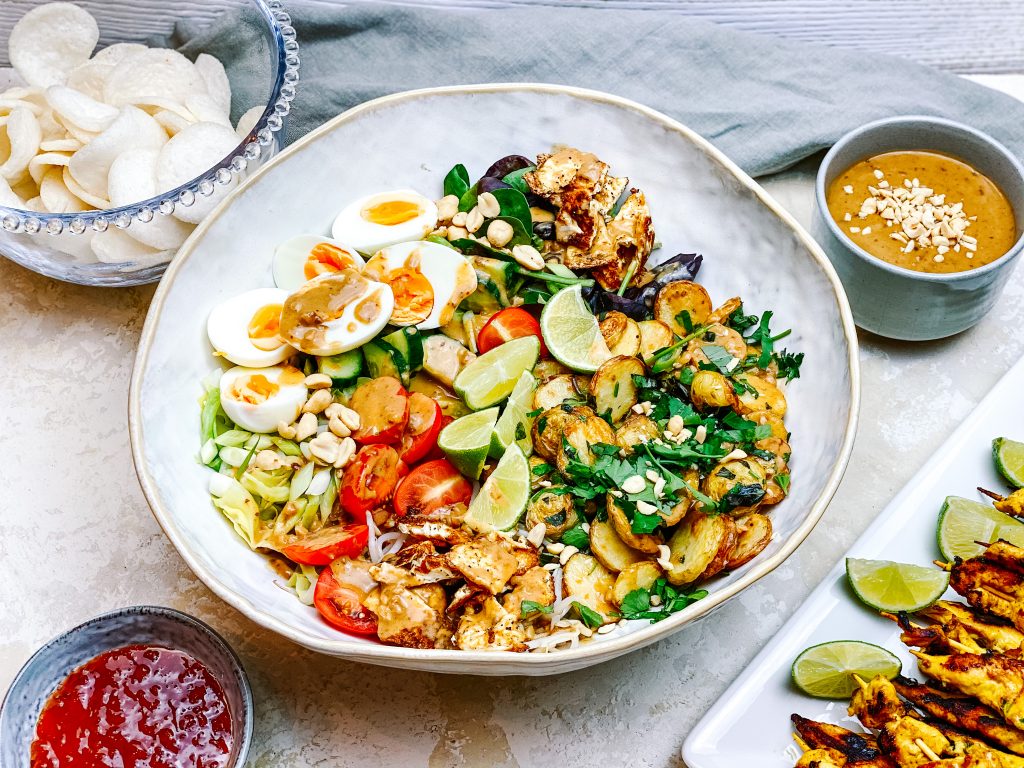
Gado Gado makes a wonderful lunch or supper. It can be served as a meal in its own right, or, for the non-vegetarians amongst us, it works wonderfully well with a plate of Satay Chicken, which rather fortuitously is traditionally served with the same peanut sauce.
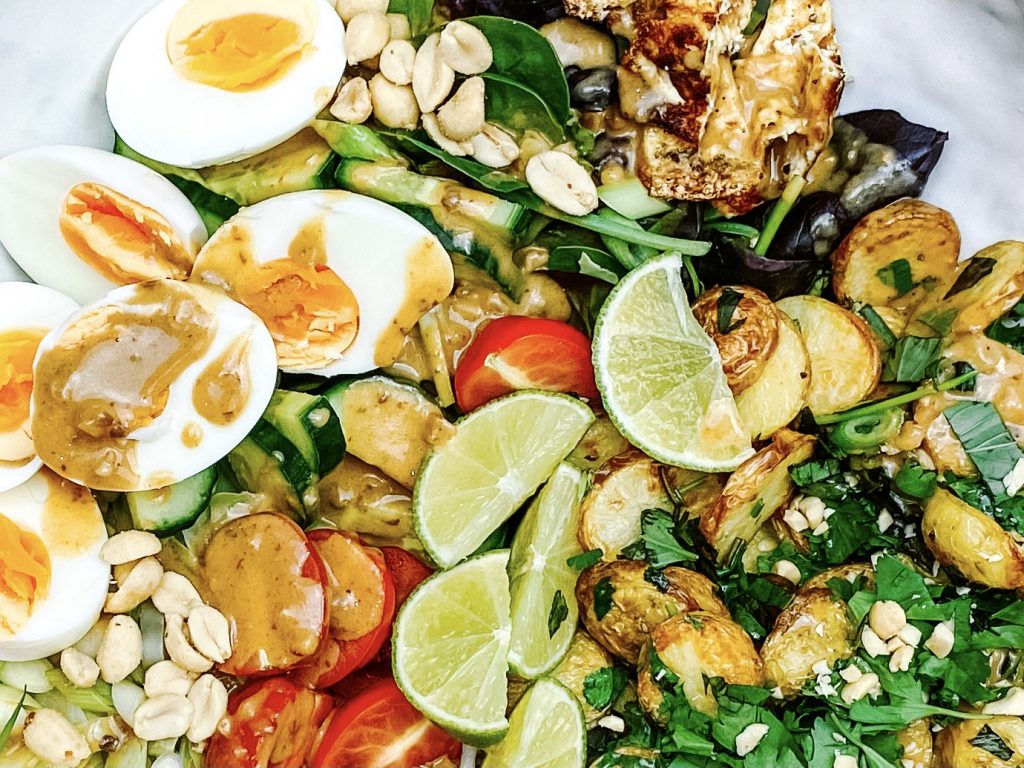
How to make Gado Gado
Collect all your ingredients together:
Peanut sauce:
- coconut oil
- red curry paste, either homemade or shop bought
- tin of coconut milk
- peanut butter, ideally natural or homemade
- palm sugar
- fish sauce
- kecap manis
- kaffir lime leaves
- tamarind paste
For the salad:
- To be cooked –
- new or Charlotte potatoes – sliced ¾ – 1cm thick
- vegetable oil
- firm or silken tofu, sliced
- sesame oil
- large eggs
- Chinese, pointed or sweetheart cabbage, shredded
- beansprouts
- Served raw –
- spinach or spinach mix leaves
- cucumber, halved and sliced
- cherry tomatoes, halved
- spring onions, trimmed and finely sliced
- chopped coriander
- shredded Thai basil
To serve:
- Chopped peanuts
- Slices of red chilli
- Wedges of lime
- Prawn crackers
- Sweet chilli sauce
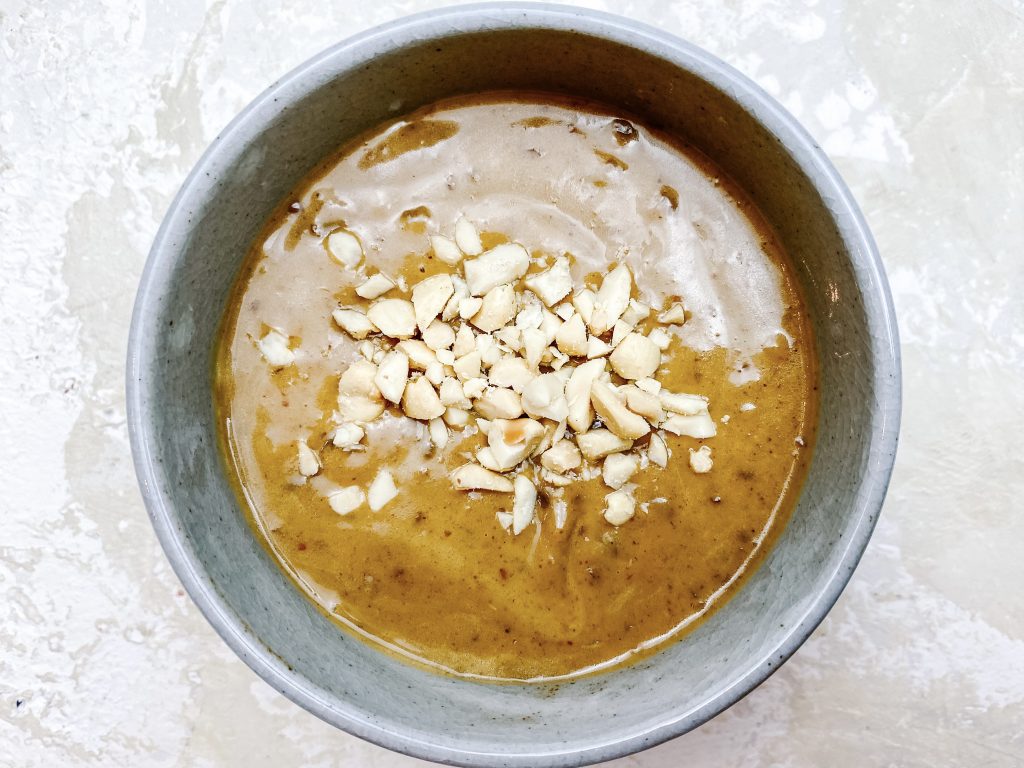
Make the peanut sauce:
- Heat the coconut oil in a pan and add the red curry paste. Cook for 1 minute until aromatic.
- Add the coconut milk and bring to a gentle simmer.
- Add the peanut butter, fish sauce, palm sugar, kaffir lime leaves, tamarind paste and kecap manis and stir well to mix. Gently simmer for 10 minutes. Allow to cool.
- Serve at room temperature or store in the fridge in a jar or bowl sealed with a lid. It will keep for up to 3 weeks in the fridge, but bring it to room temperature before serving.
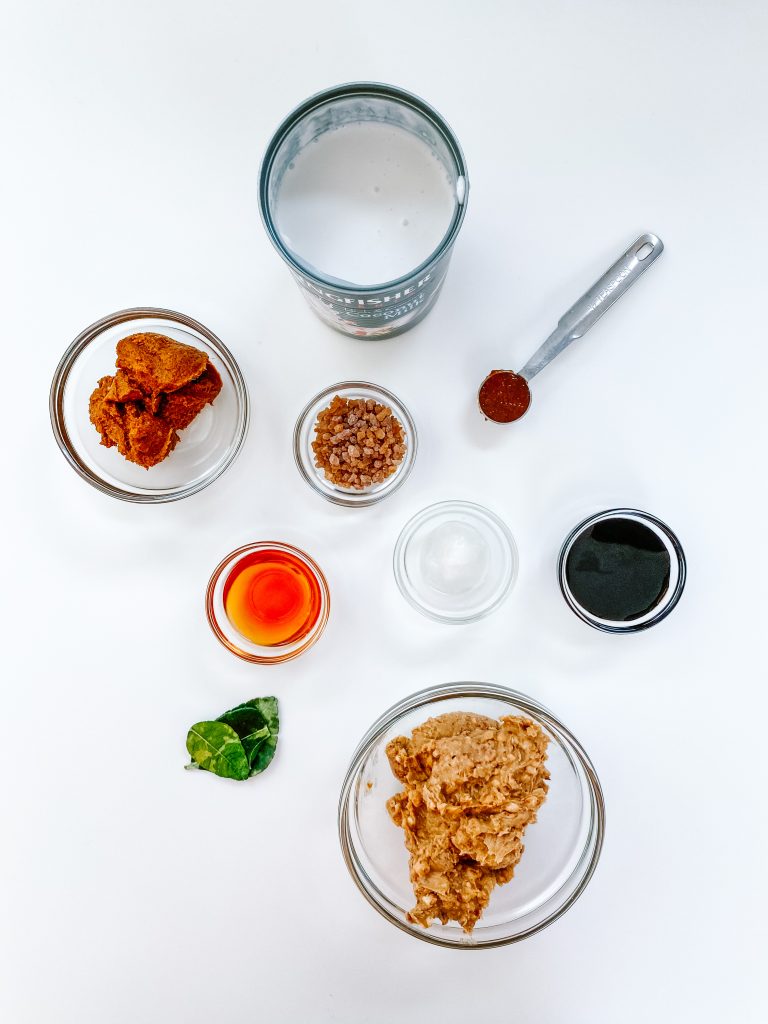
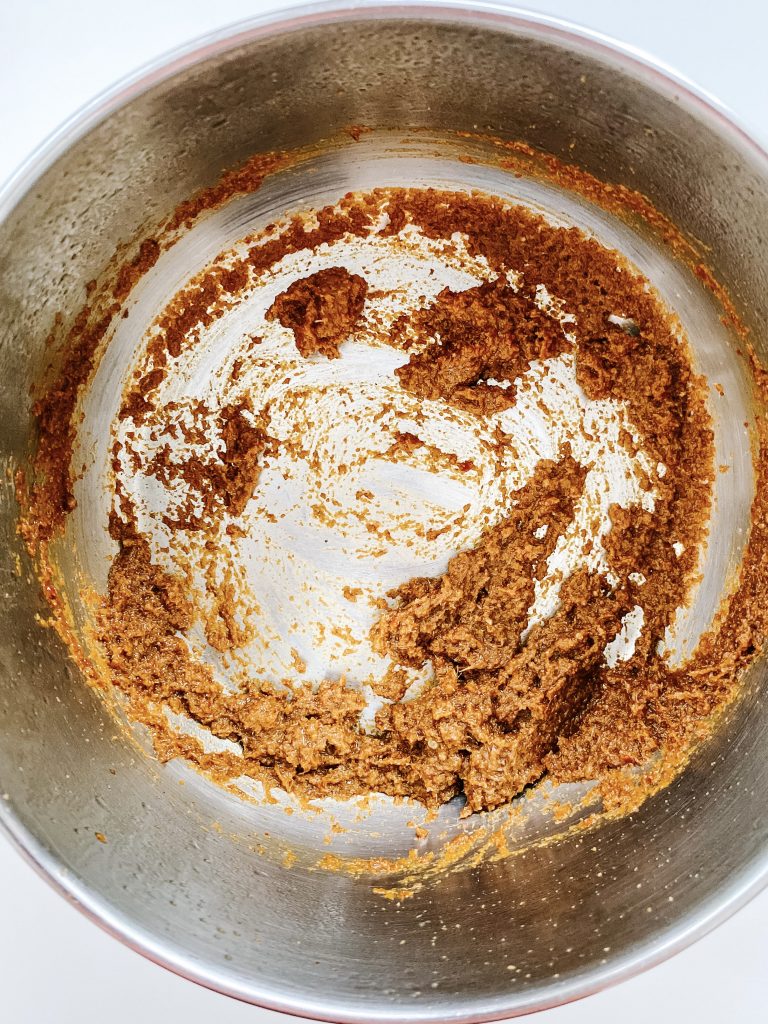
1 Cook coconut oil and curry paste 1 min 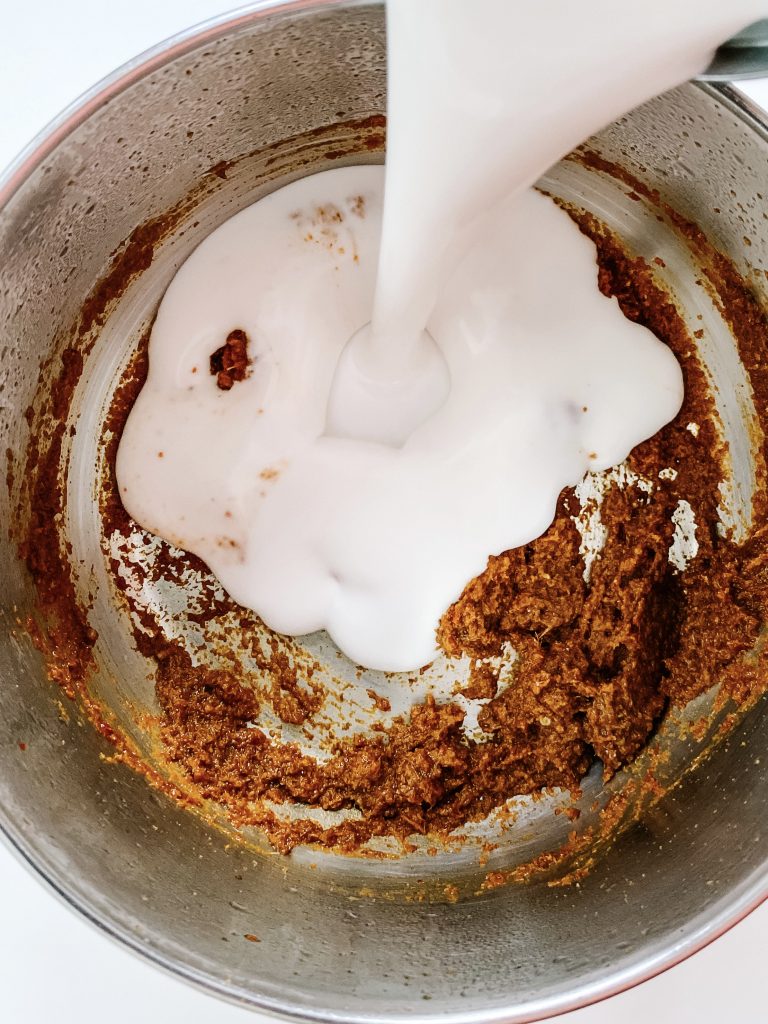
2 Add coconut milk. Bring to simmer. 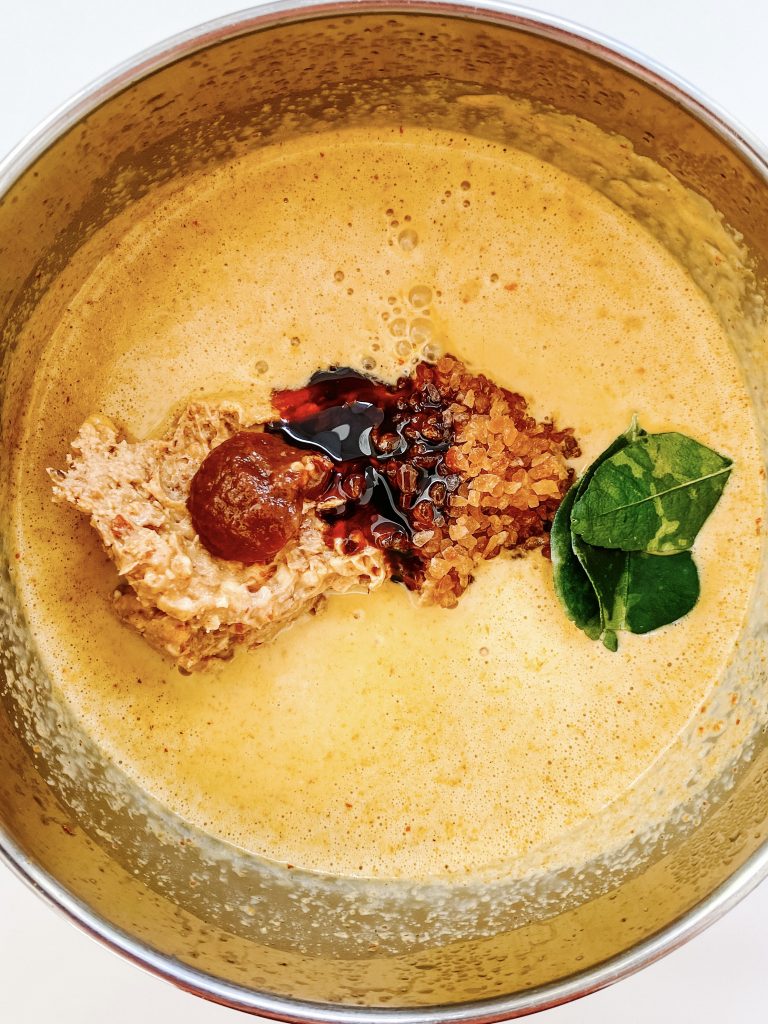
3 Add remaining ingredients 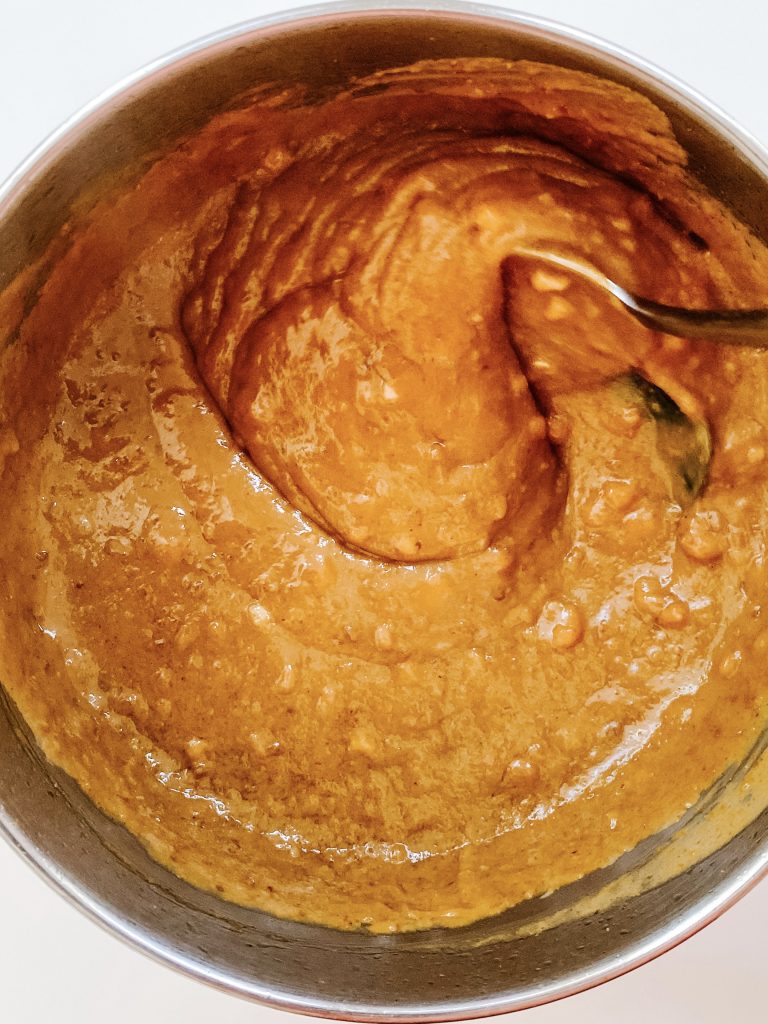
Simmer 10 mins, stir from time to time
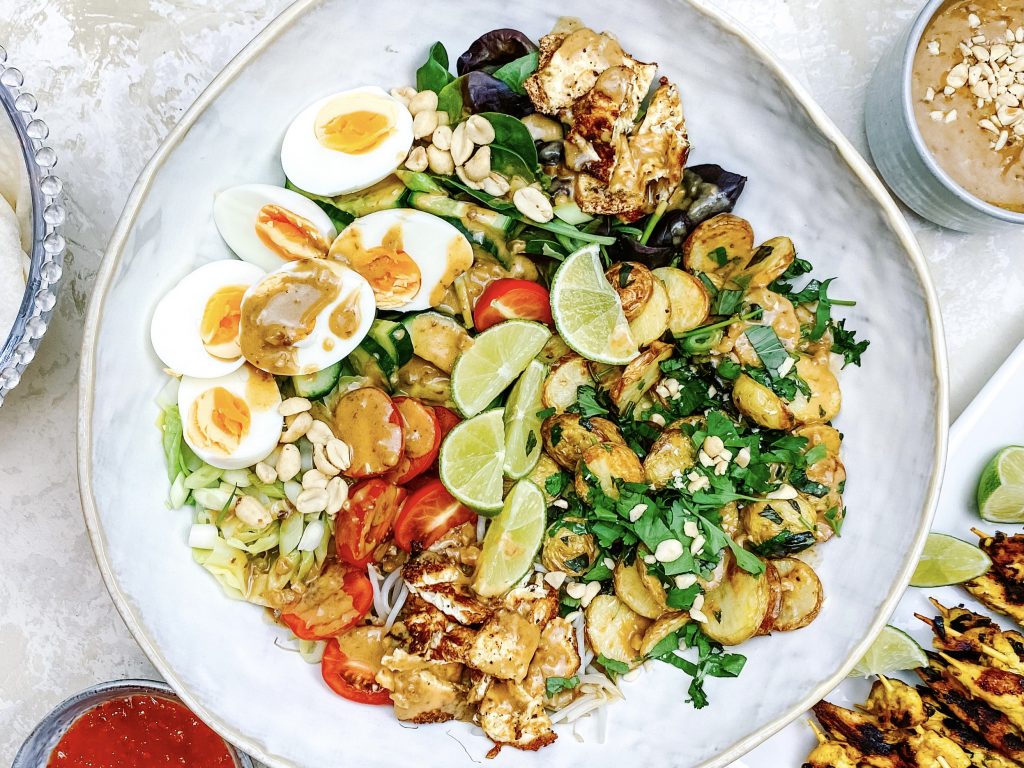
How the make the salad:
- Potatoes – slice the potatoes ¾ – 1cm thick, place in a saucepan, cover with boiling water, add a teaspoon salt. Bring to the boil and simmer for 5 minutes. Drain well, put back in the empty saucepan and mix thoroughly with the vegetable oil. Tip out onto a baking tray, ensuring they are evenly spread out, and bake in the centre of a pre-heated oven for 30 – 40 minutes until golden and crispy.
- Eggs – put the eggs in a small saucepan and cover with cold water. Bring to the boil and simmer for 6 or 7 minutes, depending on how hard you want the yolks to be. Drain immediately and cover in cold water, to prevent further cooking.
- Tofu – remove from the packaging and, if necessary, dry on kitchen towel. Firm tofu is easier to work with than silky tofu but both are delicious. Pictured here is silky tofu which broke apart when I took it out of the box. Heat the sesame oil in pan over a moderately high temperature and add the tofu. Cook until caramelised and golden on both sides and remove from the pan. Slice the chunks in half horizontally to make thinner slices and put back in the pan, uncooked side down, until it is also golden and crispy. Remove from the pan.
- Cabbage – shred the cabbage. Bring some salted water to the boil in a saucepan and add the cabbage. Bring back to the boil and drain immediately.
- Beansprouts – bring a pan of water to the boil and add the beansprouts. Immediately drain.
- Uncooked vegetables and herbs – prepare the vegetables for the salad – halve and slice the cucumber, halve the cherry tomatoes and trim and slice the spring onions. Remove the stems and shred the fresh herbs, if necessary, wash the spinach or spinach mix leaves.
- Peanut sauce: if the peanut sauce is too thick to drizzle, remove ¼ cup of the sauce and mix with a little boiling water until it is a good drizzling consistency.
- Prepare the salad –
- potatoes – when they are cooked, mix with the fresh herbs
- eggs – remove the shells and halve
- tofu – chop the cooked tofu into small pieces
- either layer the salad or add the vegetables in sections with the tofu and boiled eggs.
- Drizzle the salad with some peanut sauce and serve the remainder on the side. Decorate with chopped peanuts and chilli slices.
- Serve: with lime wedges and the prawn crackers and sweet chilli sauce on the side
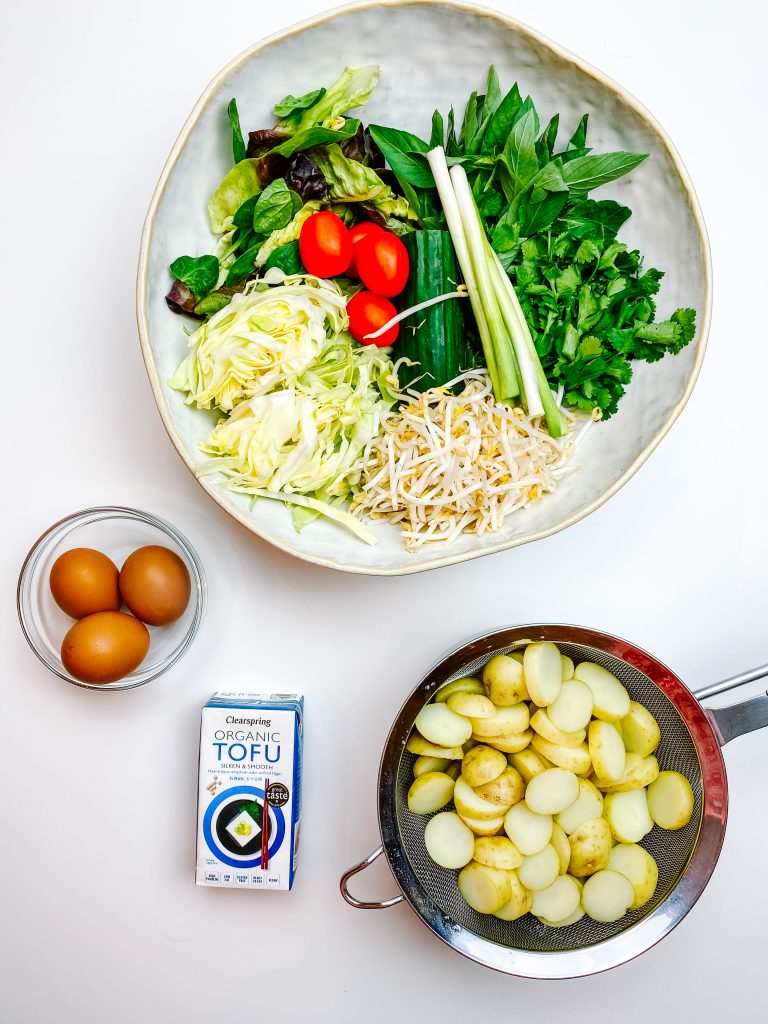
Ingredients 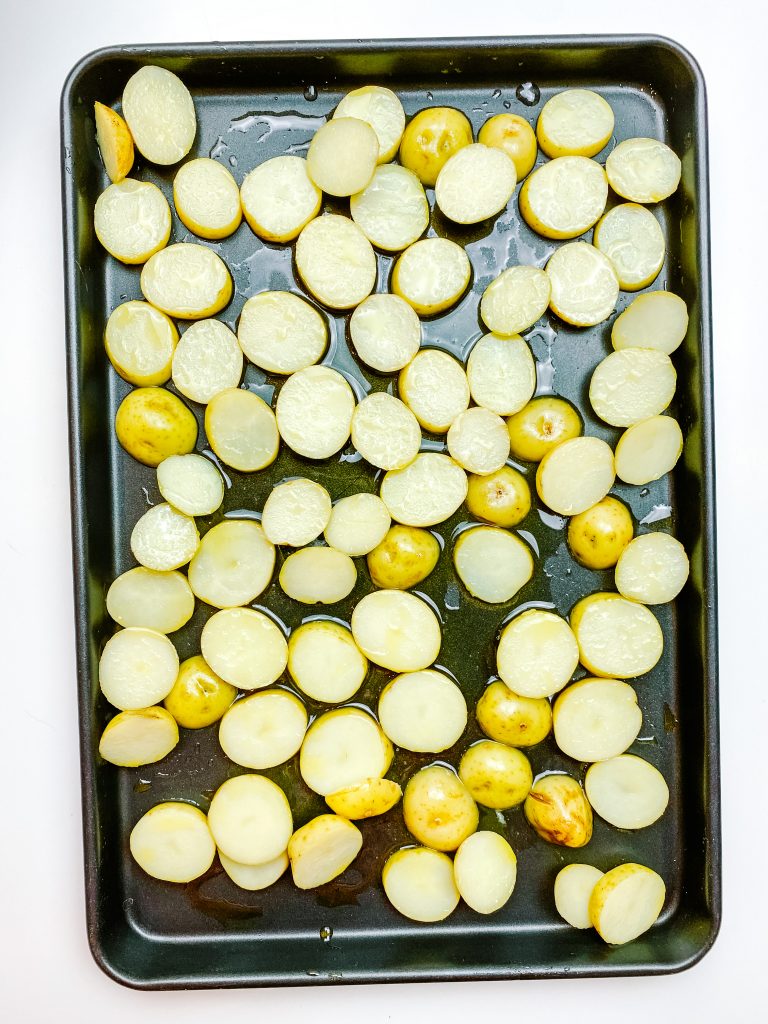
1 Cook potatoes 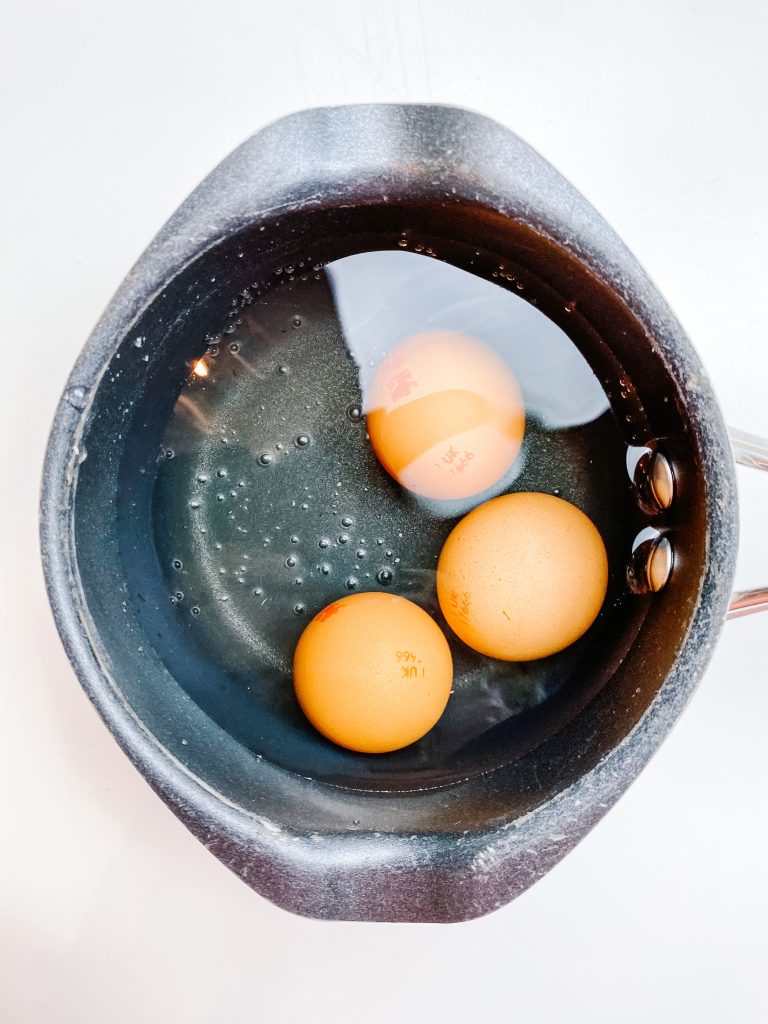
2 Cook eggs 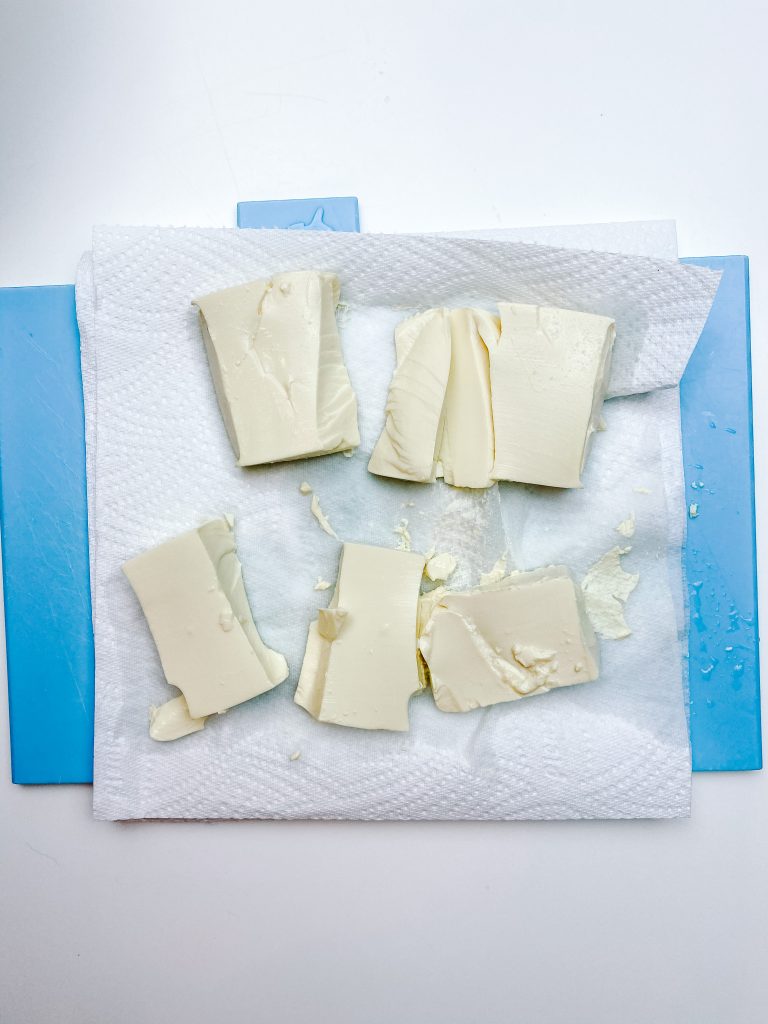
3 Prepare tofu … 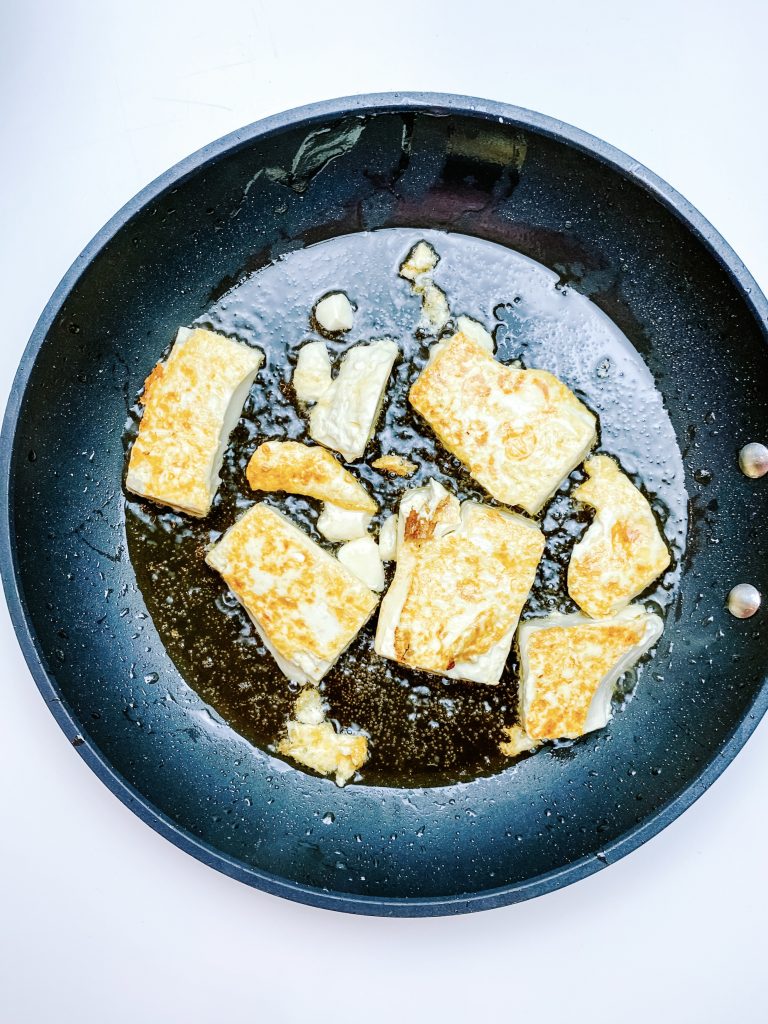
… fry on both sides … 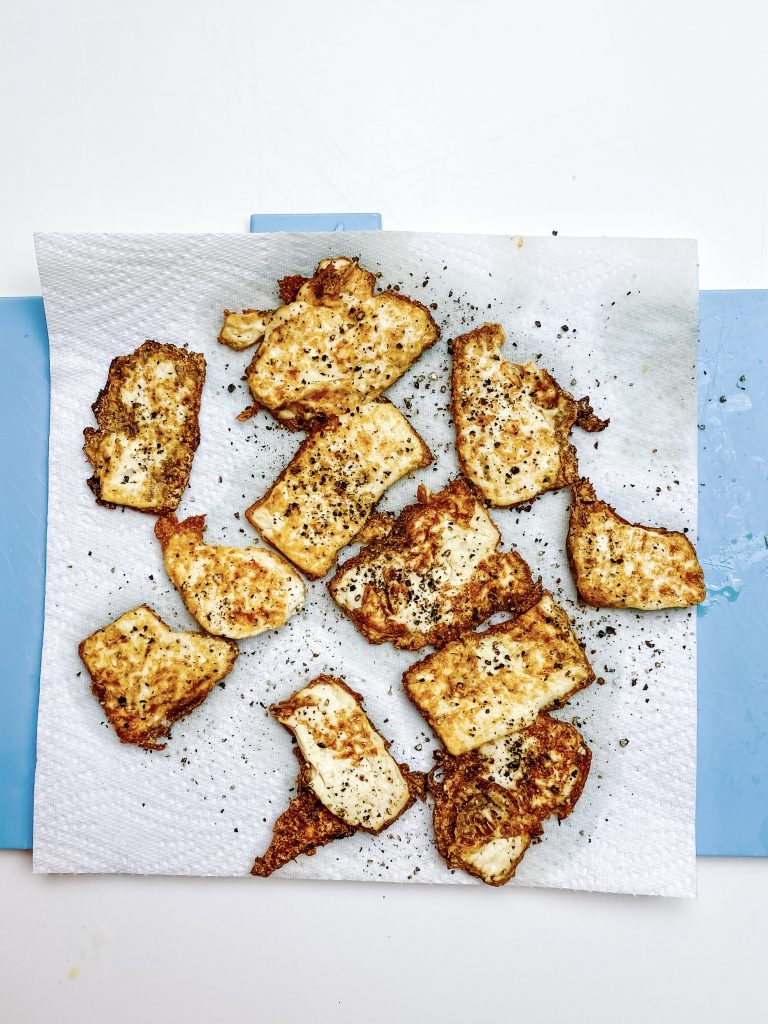
… remove from pan and slice horizontally. Fry uncooked sides … 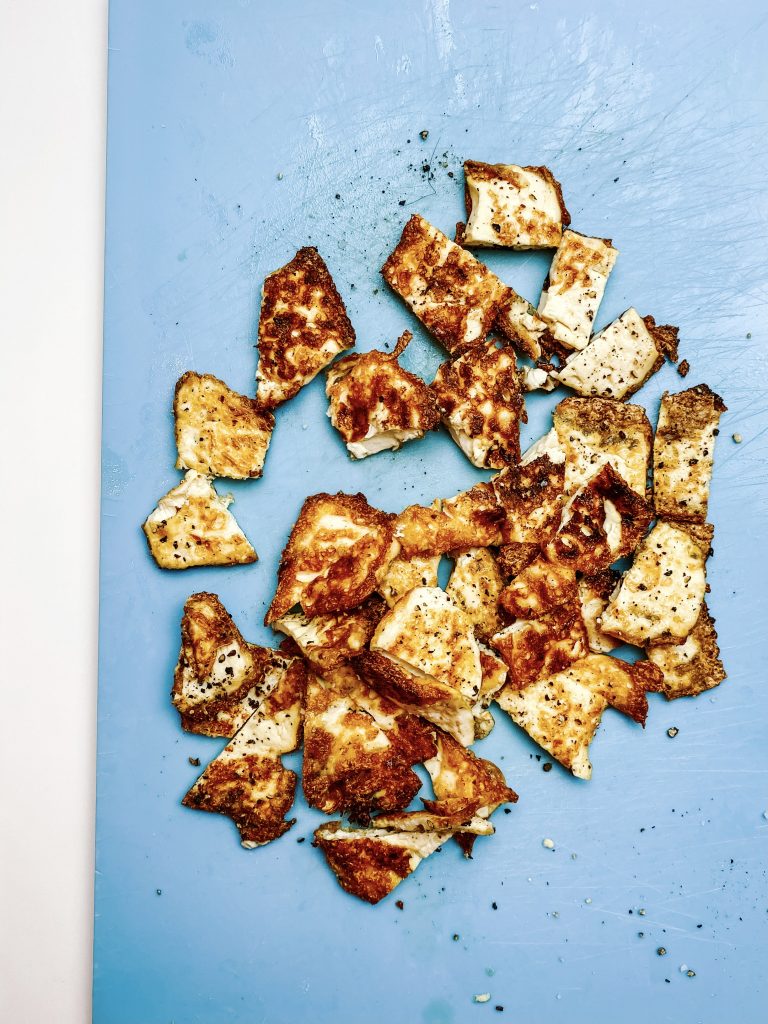
Chop crispy pieces into smaller squares 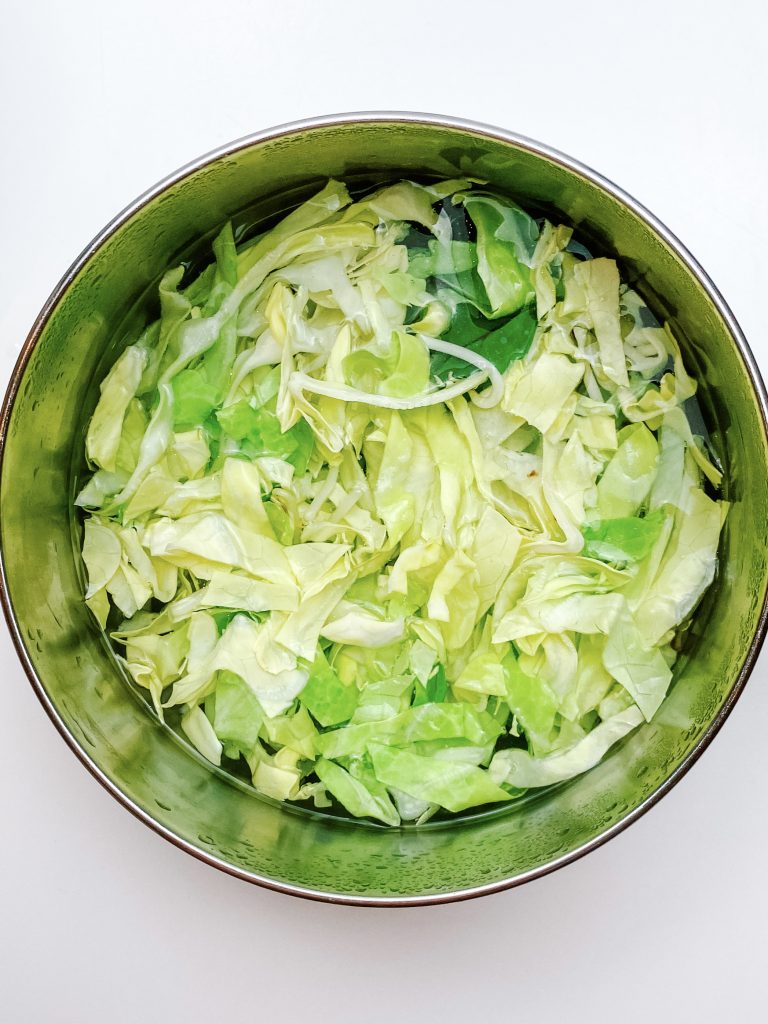
4 Bring to simmer and drain 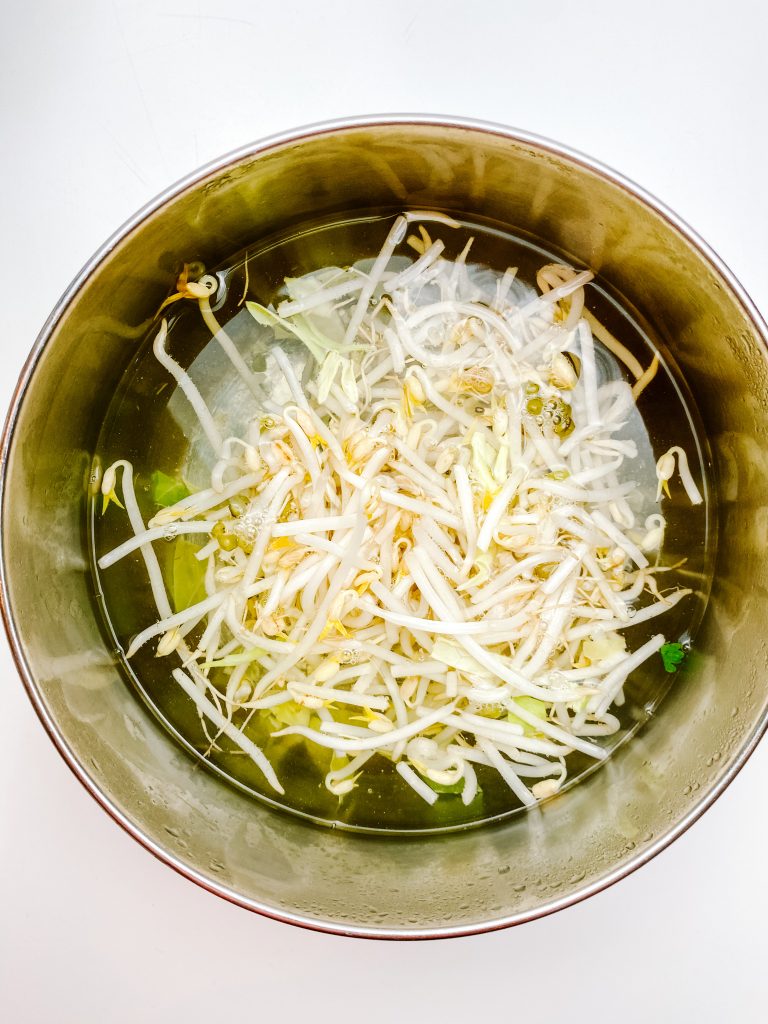
5 Add to boiling water. Drain 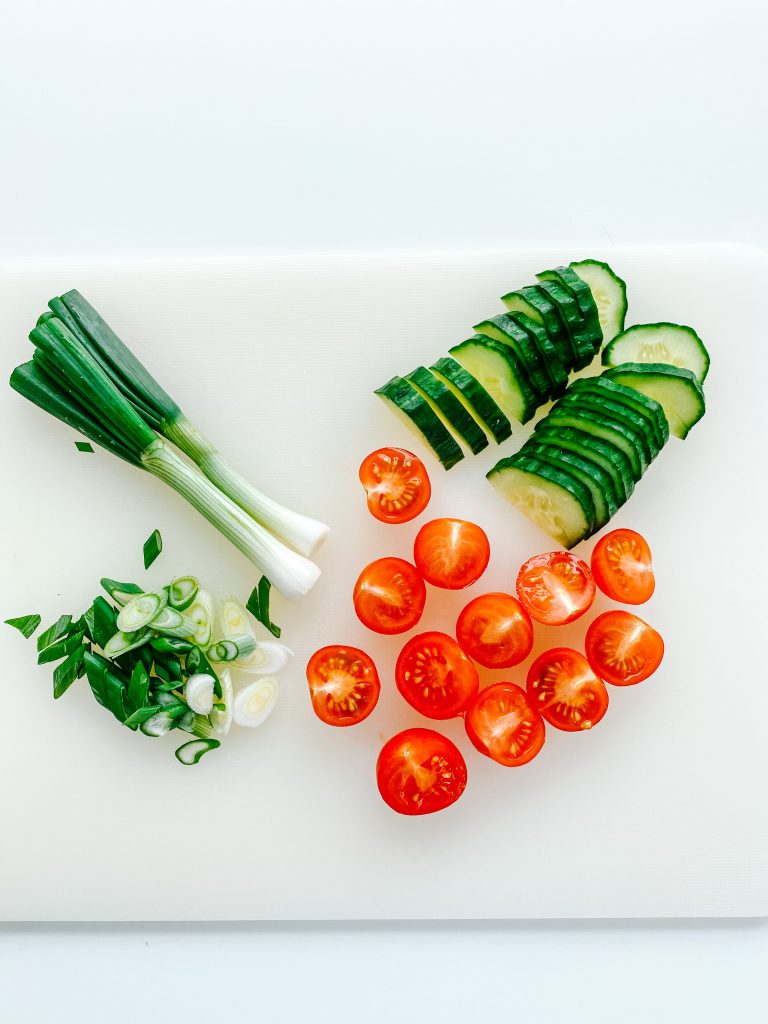
6 Prepare uncooked vegetables …. 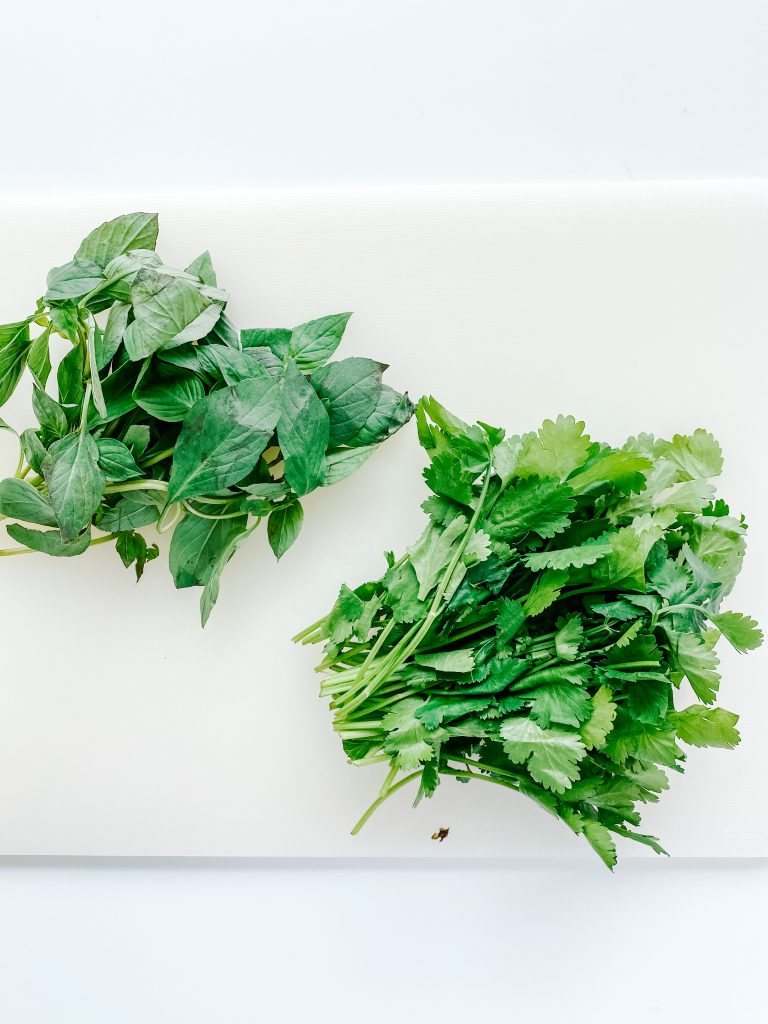
… and chop/shred herbs 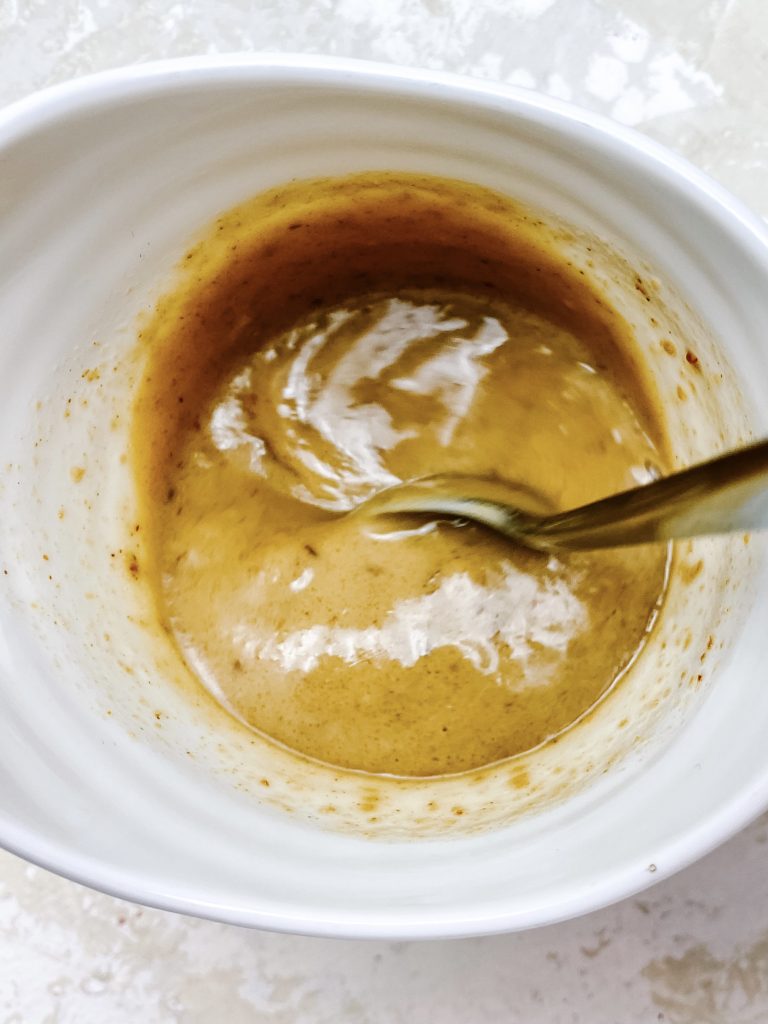
7 Thin sauce, if necessary
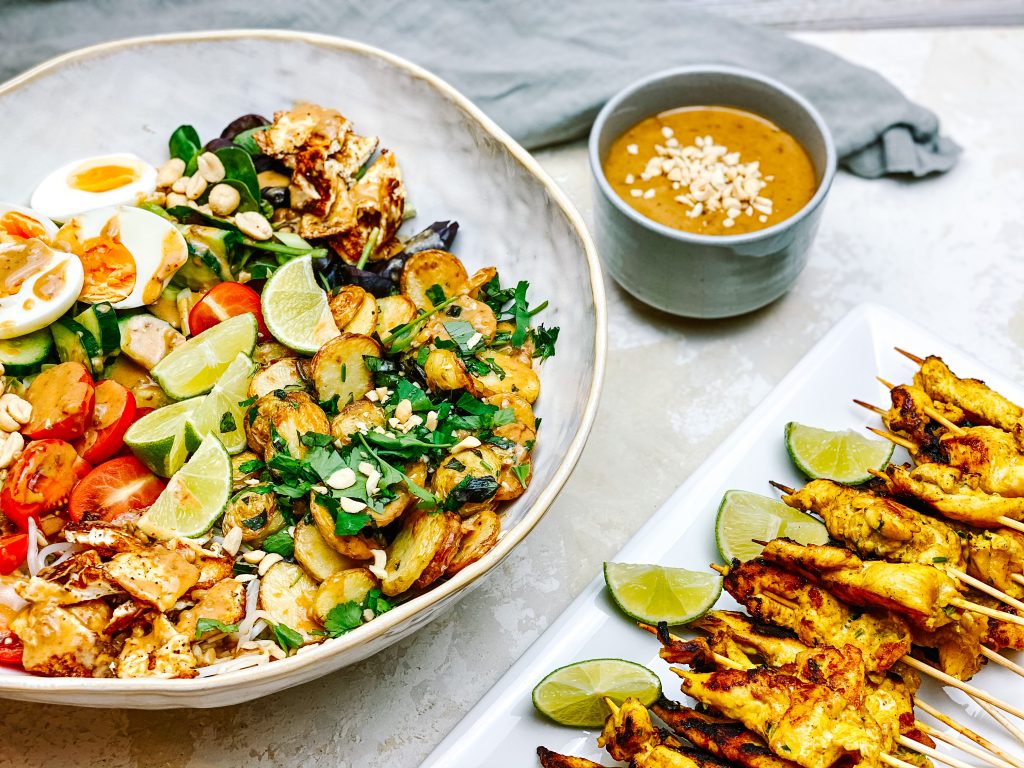
Made this recipe?
If you make this recipe, do please tag me on instagram @daffodil_kitchen. You could also leave a comment in the box directly below the recipe.
Gado Gado
Gado Gado is an Indonesian salad made using blanched or quickly steamed vegetables, cooked potatoes, hard boiled eggs, some tofu or tempeh, all drizzled with an unctuous and spicy peanut sauce and served with prawn crackers on the side. An incredible blend of flavours and textures and, even better, wonderfully healthy (mostly!).
Ingredients
For the peanut sauce:
- 1 teaspoon coconut oil
- 3 tablespoons red curry paste
- 1 x 400ml tin coconut milk
- 150g peanut butter, ideally natural or homemade
- 1 tablespoon palm sugar
- 1 tablespoon fish sauce
- 1 tablespoon kecap manis/sweet soy sauce
- 2 kaffir lime leaves
- ½ teaspoon tamarind paste
For the salad:
To be cooked –
- 400g new or Charlotte potatoes – sliced ¾ – 1cm thick
- 2 tablespoons vegetable oil
- 300g firm or silken tofu
- ½ tablespoon sesame oil
- 3 – 4 large eggs
- ½ Chinese, pointed or sweetheart cabbage, shredded
- 150g beansprouts
Served raw –
- 100g spinach or spinach mix leaves
- ½ cucumber, halved and sliced
- handful of cherry tomatoes, halved
- 3 – 4 spring onions, trimmed and finely sliced
- 15g chopped coriander
- 15g shredded Thai basil
To serve:
- Chopped peanuts
- Slices of red chilli
- Wedges of lime
- Prawn crackers
- Sweet chilli sauce
Instructions
-
Collect together your equipment (see Recipe Notes below) and ingredients.
-
Preheat oven to Fan Oven 180°C/200°C/400°F/Gas 6
-
Make the peanut sauce: heat the coconut oil in a pan and add the curry paste. Cook for 1 minute until aromatic.
-
Add the coconut milk and bring to a gentle simmer.
-
Add the peanut butter, fish sauce, palm sugar, kaffir lime leaves, tamarind paste and kecap manis and stir well to mix. Gently simmer for 10 minutes, stirring regularly. Allow to cool.
-
Serve at room temperature or store it in the fridge in a jar or bowl sealed with a lid. It will keep for up to 3 weeks in the fridge, but bring it to room temperature before serving.
-
Potatoes – slice the potatoes ¾ – 1cm thick, place in a saucepan, cover with boiling water, add a teaspoon salt. Bring to the boil and simmer for 5 minutes. Drain well, put back in the empty saucepan and mix thoroughly with the vegetable oil. Tip out onto a baking tray, ensuring they are evenly spread out, and bake in the centre of a pre-heated oven for 30 – 40 minutes until golden and crispy.
-
Eggs – put the eggs in a small saucepan and cover with cold water. Bring to the boil and simmer for 6 or 7 minutes, depending on how hard you want the yolks to be. Drain immediately and cover in cold water, to prevent further cooking.
-
Tofu – remove from the packaging and, if necessary, dry on kitchen towel. Firm tofu is easier to work with than silky tofu but both are delicious. Pictured here is silky tofu which broke apart when I took it out of the box. Heat the sesame oil in pan over a moderately high temperature and add the tofu. Cook until caramelised and golden on both sides and remove from the pan. Slice the chunks in half horizontally to make thinner slices and put back in the pan, uncooked side down, until it is also golden and crispy. Remove from the pan and drain on kitchen paper.
-
Cabbage – shred the cabbage. Bring some salted water to the boil in a saucepan and add the cabbage. Bring back to the boil and drain immediately.
-
Beansprouts – bring a pan of water to the boil and add the beansprouts. Immediately drain.
-
Uncooked vegetables and herbs – prepare the vegetables for the salad – halve and slice the cucumber, halve the cherry tomatoes and trim and slice the spring onions. Remove the stems and shred the fresh herbs, if necessary, wash the spinach or spinach mix leaves.
-
Peanut sauce: if the peanut sauce is too thick to drizzle, remove ¼ cup of the sauce and mix with a little boiling water until it is a good drizzling consistency.
-
Prepare the salad –
– when the potatoes, are cooked mix with the fresh herbs
– eggs – remove the shells and halve
– tofu – chop the cooked tofu into small pieces
– either layer the salad or add the vegetables in sections with the tofu and boiled eggs.
-
Drizzle the salad with some peanut sauce and serve the remainder on the side. Decorate with chopped peanuts and chilli slices.
-
Serve: with lime wedges and the prawn crackers and sweet chilli sauce on the side
Recipe Notes
Equipment:
- kitchen scales and measuring spoons
- chopping board and knife
- saucepans x 3
- large serving bowl
More from my site
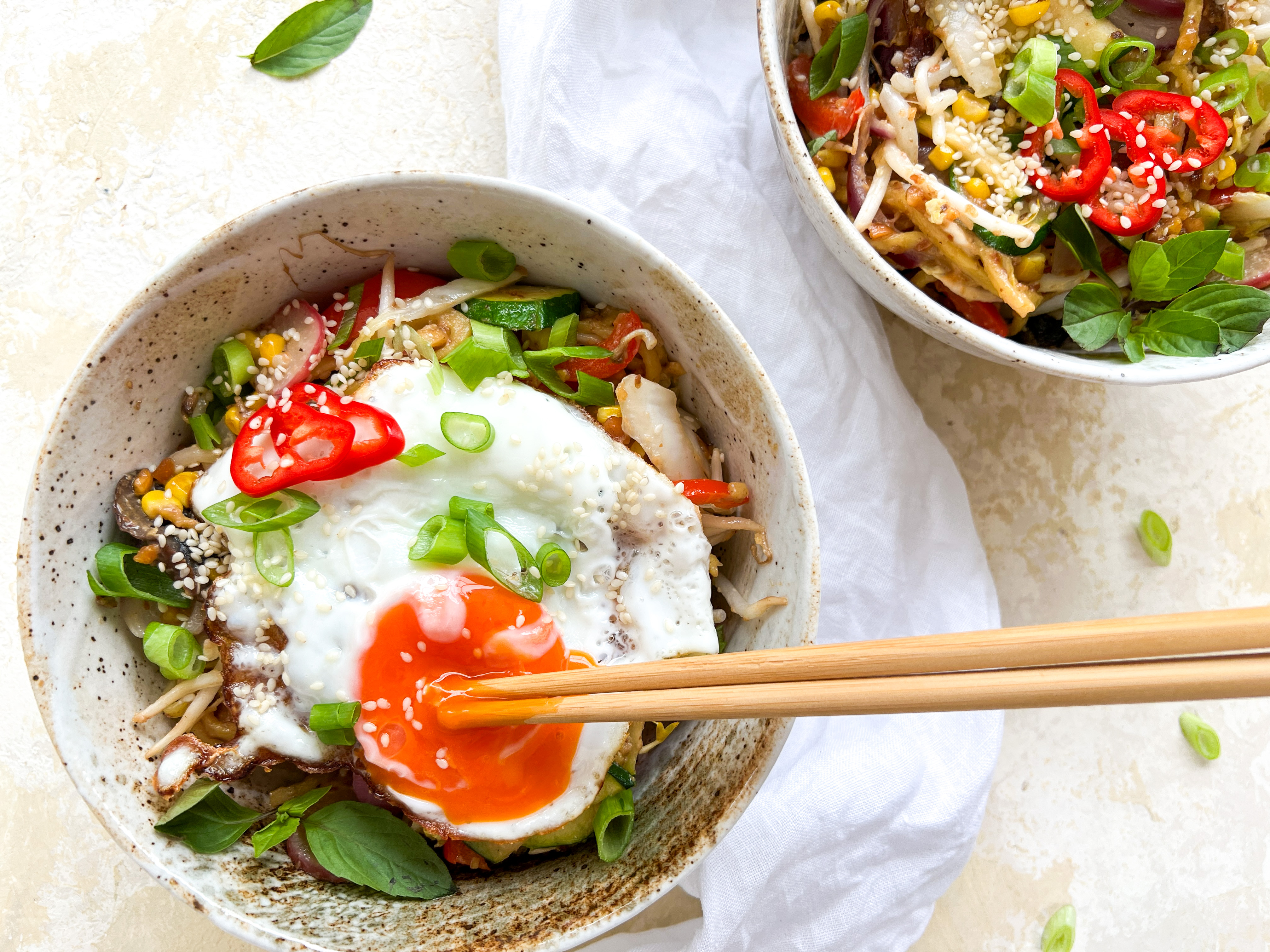 Stir-fried Asian Style Noodles and Vegetables with Peanut Dressing
Stir-fried Asian Style Noodles and Vegetables with Peanut Dressing Quick Chinese Egg Fried Rice
Quick Chinese Egg Fried Rice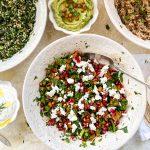 Warm Sweet Potato and Chickpea Salad with Feta Cheese, Fresh Herbs and Pomegranate
Warm Sweet Potato and Chickpea Salad with Feta Cheese, Fresh Herbs and Pomegranate Brown Rice Kedgeree with Smoked Haddock, Salmon and Coriander
Brown Rice Kedgeree with Smoked Haddock, Salmon and Coriander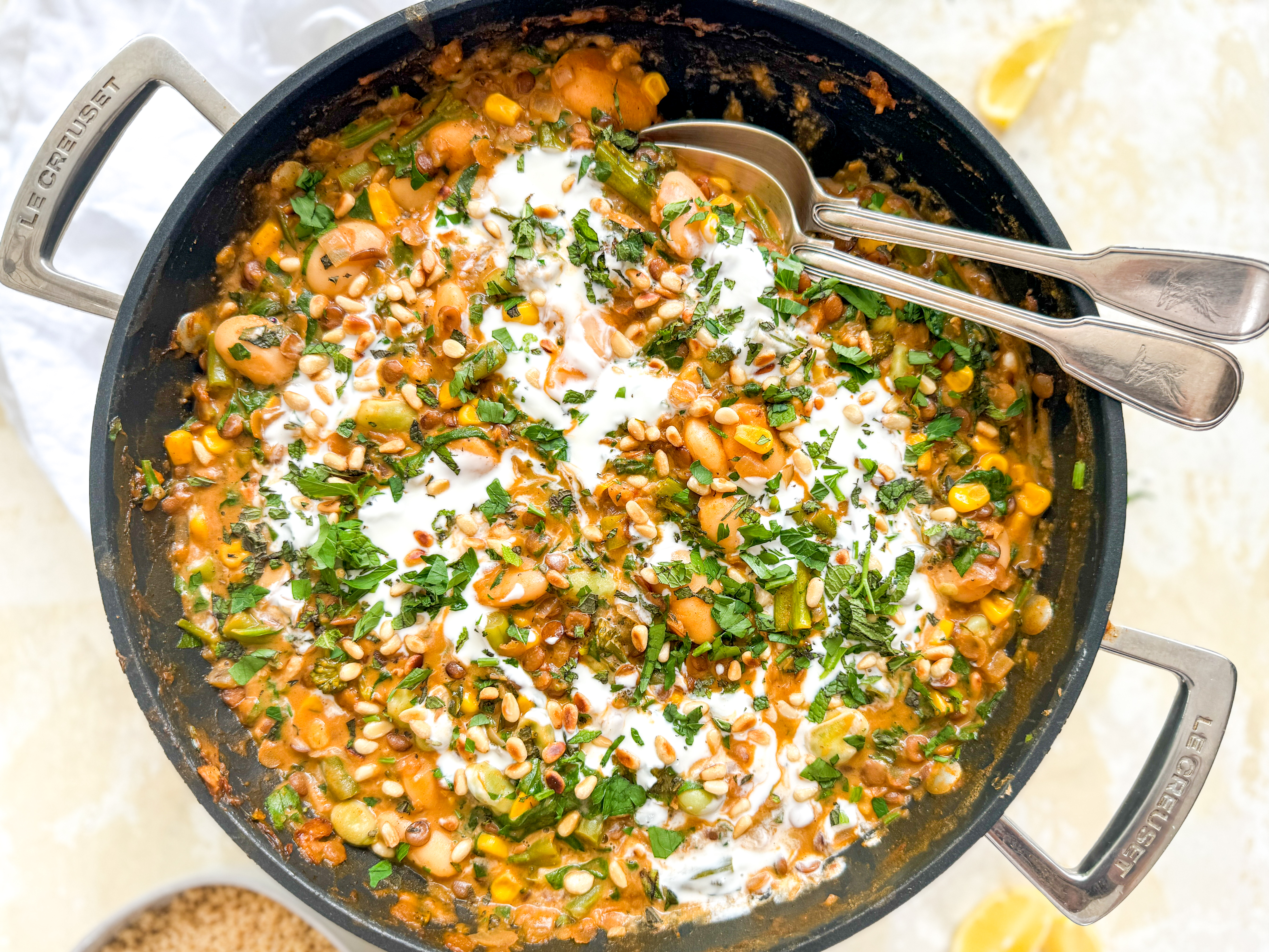 Middle Eastern inspired Butter Bean and Vegetable Stew with Parsley and Mint
Middle Eastern inspired Butter Bean and Vegetable Stew with Parsley and Mint Middle Eastern Sweet Potato and Butternut Squash Stew with Red Lentils, Spinach, Coconut and Mint
Middle Eastern Sweet Potato and Butternut Squash Stew with Red Lentils, Spinach, Coconut and Mint

Peanut Sauce
You May Also Like
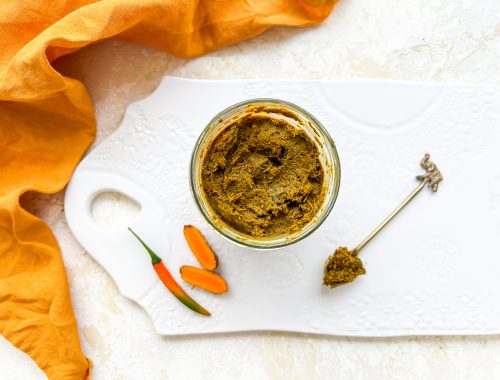
Thai Yellow Curry Paste
20th November 2022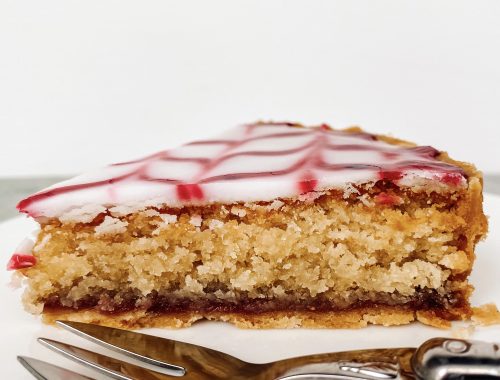
Bakewell Tart
18th January 2021